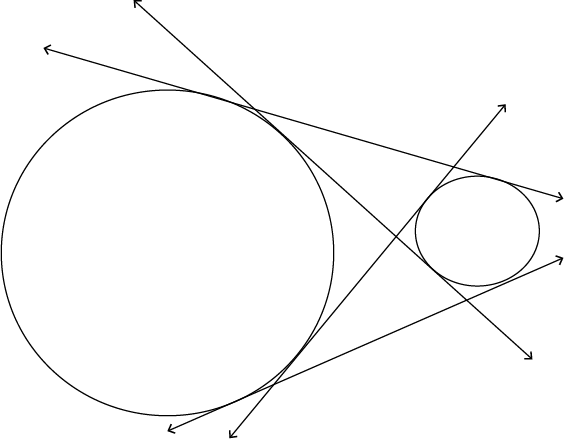Let's raise the stakes a little bit. So far, we've been dealing with one circle at a time. Suppose we have two circles. Whoa.

Can we draw a line that is tangent to both these circles? Sure we can. As a matter of fact, we can draw four such lines, which we call common tangent lines, or "common tangents" for short.

Not all pairs of circles have four common tangents. Take a look at these two circles. They're tangent to each other, meaning they share exactly one point in common. They only have three common tangent lines. See?

Sample Problem
What is an example of a pair of circles that has zero common tangents?
Zero? As in, no common tangents…at all? None? Is that even possible?

Actually, yes. See? Tangents to the outer circle won't touch the inner circle at all, and tangents to the inner circle will always be secants of the outer one. No matter where we draw any tangent, we'll never find a common one. How depressing.
A cross-section of an idealized ice-cream cone might look like this.

Here, the scoop of ice cream is a perfect sphere, and the cone is, well, a perfect cone. (We'll talk more about spheres and cones later on.) This is the ISO 440 standard model for ice cream cone design, used by frozen dessert engineers all over the world. (Disclaimer: this is completely and utterly false.)
In this cross-section, the ice cream is a circle and the sides of the cone are line segments, each of which intersects the circle at exactly one point.
If a line segment is a segment of a tangent line and has one of its endpoints on ⊙O, then the line segment is tangent to ⊙O. We sometimes call it a tangent segment.
Notice that in the ice cream diagram, the two segments that make up sides of the cone share an endpoint at the bottom of the cone. This gives those segments a special property.
Given a point P in the exterior of a ⊙O, if segments PQ and PR are tangent to ⊙O at points Q and R respectively, then PQ is congruent to PR. In other words, any two segments that share an endpoint and are tangent to the same circle are congruent. We'll call this the Endpoint-Tangent Theorem.

How can we prove it? We'll call on our old buddies, congruent triangles, to help us out. Not just any congruent triangles, though: congruent right triangles. But first we need some right triangles. Let's start by drawing segments OQ, OR, and OP.

Since QP is a tangent, it's perpendicular to OQ, and segments OR and RP are perpendicular as well. This makes ∠OQP and ∠ORP both right angles. We now have two right triangles with a common hypotenuse, OP. We know that OQ is congruent to OR because they're both radii of the same circle. By the Hypotenuse-Leg Theorem, ΔOQP is congruent to ΔORP. Since congruent triangles have corresponding congruent parts, PQ is congruent to PR.
It's the Endpoint-Tangent Theorem that ensures that ice cream stays in its cone, where it's supposed to be. Gravity helps, too.